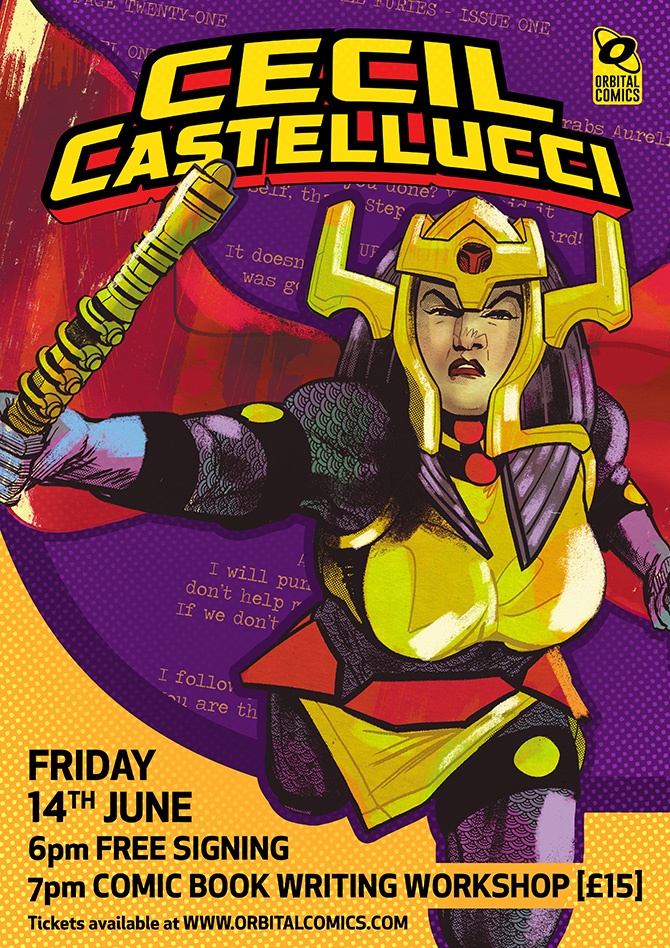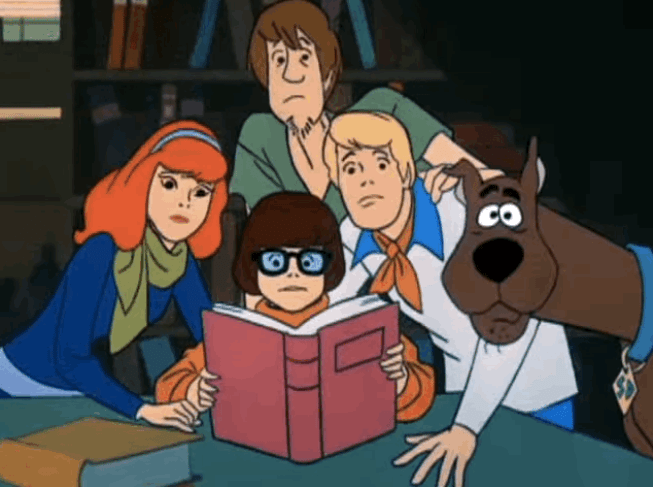A few weeks ago I attended a writing workshop at Orbital Comics in Leicester Square, London. Orbital regularly host comic related events such as life drawing sessions with models dressed in cosplay. Continuing their series of comics craft workshops, they had Cecil Castellucci in for a session on comic book writing. Cecil is an accomplished writer who specialises in books for Young Adults. Having wrapped up Shade the Changing Girl / Woman, she is currently writing Female Furies for DC Comics, and will be taking over writing duties for Batgirl with issue #37 in July. She is also a prolific novelist, creating her own worlds with the likes of Don’t Cosplay With My Heart, as well as working on well known properties likes Star Wars.

I was excited to attend this class as I feel writing is one of my weaknesses (you can probably tell from the way I write my blog posts). So how did the workshop break down. Here are some of my notes from the discussion as well as my contribution on the exercises covered in the workshop.
Why do you want to write a comic?
This was the first question that was discussed and I’m pleased because its a subject I could spend a significant amount on of time talking about. Cecil made mention of Scott Mccloud’s Understanding Comics (a fine book if you want to gain a better understanding of the form and history of comics). One powerful reason comics are such a great medium is due to the audience participation that takes place between panels, in the gutter. To bring the comic to life and to make sense of the relationship of panels, readers need to engage their imagination, allowing creators to influence their participation in the story. It really is unique, telling stories with blank spaces.
What else can comics do? You can have many different things happen at the same time. For example, two things could be happening at once, one thing in the foreground and another in the backgrounds. The beauty of this is that you don’t need words to convey either of the activities in the foreground or background. Comics allow you to play with sound effects, the physical space on the page and how it gives the reader a sense of time without explicitly defining time, symbolism as well as transition connectors between scenes. There is also what I like to call ‘the joy of discovery’ but maybe I’ll write a more detailed post on that in the future…
When creating comics, there are certain challenges that can present themselves to the creative team. If there is a team (as opposed to a single creator), you need to ensure that art style suits your story and target audience. Different types of artists sometimes require different types of writing. Does a writer provide a full script or just page description and dialogue. Cecil described the relationship as if the “writer is writing a love letter to the artist”. A writer needs to provide everything the artist needs to complete their job. But in my case the writer and the artist are the same person. Here was where I found my first take away from this workshop…
Lesson 1: Choose a writing style that suits you
I have always taken the path of writing a full script for my comics. I wrote a full script for the first issue of CATAPULTED. The idea was that if I could do all my mental thinking at the writing stage then I could avoid rework during the layout and penciling stage. However, the challenge is that it can be hard to picture everything and to determine what method of delivering the story on the page.
Cecil had shared one style of script she had used for a children’s book that left a lot of the visual decisions up to the artist. This is a great fit for me. When I saw the format I thought it would allow me to focus on great dialogue whilst allowing flexibility to leverage the format for maximum effect. This means no overthinking panel descriptions and camera views etc. Instead, I can just summarise the actions taking place on the page and maybe some notes on the ‘feeling’ or emotional vibes that the reader should be feeling. This would significantly speed up the writing process and it’s something I’ll be employing this for when completing CATAPULTED.
In addition, some other good writing advice is to review dialogue after pencils have been completed to see if you can reduce the amount of words used. Another important point is to read your dialogue out loud! This is vital in ensuring that dialogue reads well and suits the characters. It might sound obvious but sometimes I settle for reading back dialogue in my head rather than out aloud.
The Quiet
Comics have a strength in showing quiet. You can have pages and pages of images without dialogue. It’s something you can’t really do in novels, and comics does it in a way that is more subjective when compared to movies, making it unique. You can use it to establish mood and tempo and it can even allow the readers to pause completely, perhaps to dwell on a large splash page.
It’s definitely a strength in a comic creators tool box in addition to the various types of relationships you can have with words and images. We didn’t dwell on this for too long but it’s definitely a topic worth exploring as I think its often overlooked.
Workshop Exercises
One of the aspects of this workshop I really valued were the workshop exercises. The participation really encourages thinking which leads to progress. The first exercise was to think a little bit more about characters and how they all have elements in common with Superman.
For example, think about the following characteristics:
Storytelling skill or superpower:
Weakness: Lois, boy scout attitude, Kryptonite
Enemy: Lex Luthor, injustice
Something he loves : Lois Lane, Justice
Characters Special place: Fortress of Solitude
Group of friends or Scooby gang: Jimmy Olsen, Lois, Martha, Other heroes
This analysis can work for almost any character, even ones that aren’t in the superhero genre. A character suggestions from the class were Don Draper from Mad Men and Walter White from Breaking Bad, shows I’ve not watched before, but from this exercise I was able to get a sense of what the characters were about.
Scooby Gang
One of the interesting elements from that exercise was to consider the side characters of a story, or as it was more interestingly put, the Scooby Gang.

Take our good friend and pooch, Scooby Doo. Who is his Scooby Gang? We have Shaggy Rogers, Fred Jones, Velma Dinkley, and Daphne Blake and Scrappy-Doo. Side characters can have an interesting impact on the main character. Take another example of a Scooby Gang, in the Wizard of Oz Dorothy is put in a situation far away from home and the side characters are literally her qualities/personality. You have her brain, her heart, her courage displayed in the side characters. As with most Scooby Gangs, they can help writers to calibrate the main characters.
Writing Exercise
The last part of the workshop was what I found most valuable and it honestly put me out of my comfort zone a little. Writing isn’t my strongest skill and here I was challenged with writing a page in just a few minutes.
Writing Challenge 1
The first writing task was to take a one page comic of 6 panels, where two women are talking in a cafe and to create some dialogue. The speech bubbles were blank and the idea was to come up with a short story and dialogue. I really struggled at this, staring blankly at the image in the PowerPoint presentation until some kind of dialogue formed.
I tried to create some sense of mystery and a twist at the end. The idea was that one woman was cancelling her dog walker without actually mentioning that she has a dog. I don’t think it came off well. It went a little like this:
P1: thanks for meeting me at short notice, I really needed to speak to you.
P2: It’s about Ted? / What about Ted?
P3: I’ve decided to give him another chance with me. / That means this has our time has to end…
P4: But I thought we had a good thing going?
P5: It’s ok, I’m sure you’ll find someone else
P6: Probably the best time to tell you Ted chewed up your laptop…
The second task was to take a title and to create a story based on the number of panels you were assigned. The title was ‘A Trip to Mars’ and you were either assigned, 1 (splash page), 3 or 5 panels. I got assigned 5. Here was my story:
Panel 1: View of an astronaut in space suit complete with helmet, from over the shoulder in the foreground looking out of the porthole window of the spacecraft with Mars shown as a small red circle, shown in the background.
Panel 2: Close up view of around the capsule, showing empty food sachets.
Panel 3: Close up view of empty water bottles and indiscernible letters written with a pencil worn to the nub.
Panel 4: Exactly the same panel description as panel 1 however Mars is much larger in the porthole window. up the view port.
Panel 5: Red light reflects onto the astronaut now shown face on, revealing a skeleton in the astronaut suit.
The next exercise was to write another story using the same title (‘A trip to Mars’) but this time the assignment is to convey the passing of different amounts of time. The assignments were 1 day, 1 month and 1 year. I was assigned 1 year.
Panel 1: Smiling astronaut is blowing out hand carved candles on a cake, shavings are all over the floor.
Panel 2: He looks glum after blowing it out the candles .
Panel 3: Extreme close ups of his hands carving something.
Panel 4: Open panel of floating shavings in zero gravity.
Panel 5: Looking sadder, thinner, with bags under his eyes and an unshaven face, he places a finished hand carved candle into a new cake, one candle more than the first panel.
And that brought me to the end of the workshop! It was a really nice evening with a great writer and a good crowd and I’m looking forward to attending similar events in the future.